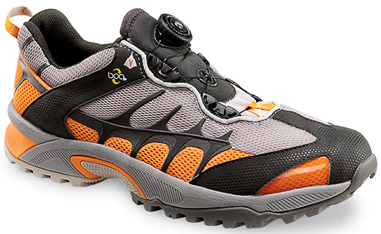The Gear Junkie: Wintertime Trail Runners 2008
By STEPHEN REGENOLD
Deep snow and icy trails are upon me here in Minnesota, my home state and an ideal proving ground for footwear made to take on winter. Specifically, over the past two months I’ve tested three winterized trail-running shoes, all water resistant and warm enough for cold days, but with enough spring to propel my stride adequately during nightly training runs and the occasional foul-weather race.
Of the three models I’ve been testing, the Salomon Speedcross 2 are most impressive. These $110 runners have a thick insulating upper and a unique sole with dozens of V-shape lugs made of a soft rubber.

Salomon’s (www.salomon-sports.com) principle idea with this “Winter Contagrip” sole was to employ pliable rubber that stays always soft—and thus always grippy—in the cold. In my tests, the concept proved true, as the shoes grabbed icy ground better than the other footwear in this review.
Designed for trail running, the Speedcross 2s have a big cushioning heel to dampen the blow when you land in the backseat. For me, this padding seemed overkill, making my stride slower if I didn’t consciously avoid landing on my heel. It is a nice cushion against gravity while running downhill in bumpy terrain, however.
Like most Salomon footwear, the Speedcross 2s have a Kevlar lacing system, which employs a slide-cinch to tighten the shoe on your foot. They weigh about 11 ounces per foot, which makes them the lightest and most nimble shoes—that is to say the fastest—of the bunch.
Second in line, La Sportiva’s Ultranord GTX-XCR were the best shoe for snow, as they come with ankle gaiters. These Gore-Tex shoes are what I use now for long trail runs and fast off-trail treks in snow. Water can’t get in easily while tromping through slush, and snow stays out almost completely because of the company’s (www.sportiva.com) slick gaiter system.

The $125 shoes have a roomy toebox and an aggressive outsole for traction. They are comfortable and supportive, almost as rigid as a light hiking boot.
For flat trails without deep snow, however, I preferred the Salmons over the Sportivas, as the latter is stiffer, slower and about three ounces heavier per foot.
Finally, Vasque Footwear’s Aether Tech shoe took a middle ground between the Salmon and Sportiva models, balancing speed with support. The $120 Aethers have a neutral midsole, meaning the arch area is pretty flat. I like this, as there is not a lot of heel padding or a rocker feel to the shoe, keeping you landing on your midfoot rather than slamming down on the heel with each stride.

The company (www.vasque.com) touts the Aethers as “weather-proofed” shoes for year-round trail running, which is nice if you don’t want to drop the money on a shoe that can only be used in the cold months. But this versatility makes them the least water-resistant, as the upper material must breathe more to accommodate warm weather use as well as the cold. Hold them under running water and it seeps right in.
Its lacing setup—the BOA Technology closure system—is fast and clean, letting you push down and twist a knob to secure the shoe in two seconds.
Compared with the other two models, the Vasque shoes were a bit large and wide for their size. They weigh about 13 ounces per foot in my size (13), and the grip is the least aggressive in the bunch, though still I rarely slipped on snow or ice.
(Stephen Regenold writes The Gear Junkie column for eleven U.S. newspapers; see www.THEGEARJUNKIE.com for video gear reviews, a daily blog, and an archive of Regenold’s work.)






